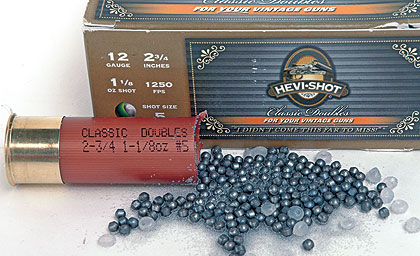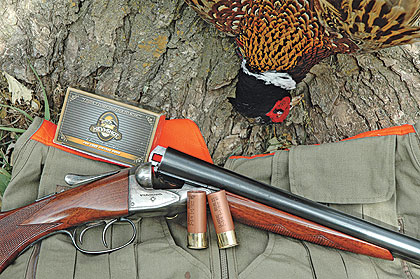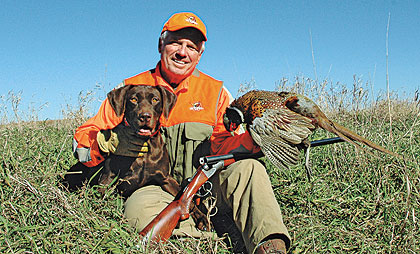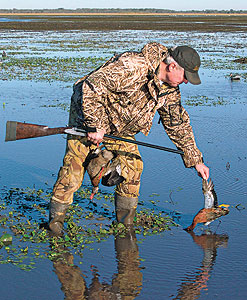These new loads will allow you to continue shooting your favorite vintage guns.
By Layne Simpson
Do you remember the Ithaca Mag-10 shotgun? For the benefit of those who do not, the Mag-10 was introduced around 1981 and although it had a few minor design problems, it was the first commercially successful gas-operated autoloader built from the ground up to handle the 10-gauge shotshell.
 While the pellets in a Classic Doubles load are nontoxic, they are much heavier than steel shot but with a hardness that compares quite closely to lead shot, so they are safe to use in guns built prior to the introduction of steel shot. |
In 1989 Remington purchased manufacturing rights to the gun, improved its design and reintroduced it as the SP10. I have one of the first SP10s built and even with today's abundance of 12-gauge waterfowl guns chambered for the 3-1/2 inch shell, I still prefer it when using steel shot simply because it is more comfortable to shoot.
Coincidentally, a friend of mine who spends more time duck hunting each year than anyone else I know and who just happens to be my dentist, still owns the Ithaca Mag-10 he purchased around 1985. In those days lead shot was still in use for waterfowl hunting and his ability to reach high into the sky and bring down geese with his Ithaca and 1-7/8 ounces of 2s became legendary. Needless to say, he loved that gun.
A few years after Tom bought his Mag-10, the use of nontoxic shot on waterfowl became mandatory so without missing a beat he switched to iron shot (or steel shot as it is more commonly called). And since steel shot is several times harder than lead shot, it eventually became common knowledge that its use could damage the barrels of shotguns built to handle lead.
This is due to the fact that a charge of steel shot of a particular size possesses less fluidity than a charge of lead shot of the same size and this, along with its greater hardness, gives steel shot greater resistance to compression as it travels through constricted areas of a shotgun barrel, most notably at the forcing cone and the choke.
With the exception of some of the old side-by-side doubles with their extremely thin barrel walls, damage seldom occurs at the forcing cone due to the fact that the wall is comparatively thick at that point. The choke is another matter entirely simply because barrel wall thickness in that area of many guns built prior to the introduction of steel is not thick enough to handle shot having a greater hardness than lead.
As my friend Tom found out the hard way (no pun intended), the use of steel shot in an older gun can eventually iron all choke constriction from its barrel. His Mag-10 came from the factory with close to .030-inch of choke constriction and by the end of his first season with steel shot all choke had disappeared from its barrel. In his case, the cure was no further away than his local gunsmith who installed screw-in chokes designed to withstand the ravages of steel shot.
This is still an option for many older guns but it is not a modification I would want to make to some of my vintage guns simply because I prefer to keep them in their original condition. Examples are Westley Richards and Fox doubles built prior to World War II and an L.C. Smith purchased by my father during the 1940s. Those and a few other guns will remain original for as long as I own them and I simply cannot imagine either having their barrels threaded for screw-in chokes.
When using my older guns for waterfowling and when hunting in upland areas where lead shot is not allowed, I use loads with nontoxic shot with a hardness comparable to lead shot. I believe Bismuth was the first such shot to come along and I used it a lot, especially in several 12, 20- and 28-gauge guns. With a hardness and gravimetric density close to those of lead, its performance was superior to that of steel shot and yet it was safe to use in guns built prior to the introduction of steel. Unfortunately, Bismuth was recently discontinued so it is no longer an option.
 When teamed up with my 1920s vintage Fox Sterlingworth, the new Classic Doubles load did an excellent job on Iowa pheasants. |
Another great nontoxic that also came and went was Tungsten-Polymer from Federal. Its density was even closer to that of lead and it too was vintage gun friendly but it was never offered in anything but 12 gauge. I have a good supply stashed away mainly because my old Fox Sterlingworth delivers excellent patterns with it.
This leaves us with two types of nontoxic shot suitable for use in old guns. Tungsten-Matrix has been with us for several years and I first had the opportunity to try it in Argentina shortly before it was approved for use in the United States. By blending just the right mount of tungsten metal and plastic (or polymer as it is called) its maker, Kent Cartridge, produces a shot with a density slightly higher than that of lead but soft enough to be used in vintage guns. It is presently available in 12 and 20 gauge.
The latest shot on the nontoxic block is called Classic Doubles. And while its name might lead one to believe it was developed for double-barrel guns it works equally well in pumps and autoloaders. This load is brought to us by EnvironMetal, the developer of HeviShot and HeviSteel and it is already approved by US Fish and Wildlife for use in any area where nontoxic shot is required.
With a gravimetric density of about 10 gms/cc, it is considerably heavier than steel at 7.86 gms/cc and close to the 11 gms/cc of lead shot. It hardness also compares quite closely with that of lead, making it equally suitable for use in older guns. And whereas the pellets of HeviShot pellets we are accustomed to examining are irregular in shape and vary considerably in weight, Classic Doubles pellets are quite uniform in weight and uniformly round as well.
Exactly how Classic Doubles pellets are formed is a trade secret but the process begins with a mixture of tungsten, nickel and iron in powdered form and high pressure is used to form pellets of the desired size. Accustomed to seeing a lead pellet flatten when squeezed between the jaws of pliers, I was surprised to see a Classics Double pellet crumble back to its original powder form.
This caused me to initially suspect the pellets might suffer from setback fracturing during firing, a problem experienced with Bismuth shot when it was first introduced. At the very least I figured a few individual pellets would disintegrate when being slammed a
gainst the forcing cone and choked section of the barrel. Based on the limited amount of testing I have done, this does not appear to be the case.
During my tests I cut open several 12-gauge shells containing 1-1/8 ozs of shot, counted the number of No. 5 pellets contained by each and arrived at an average count of 203. I then fired five rounds at paper patterning sheets, counted the number of holes in each sheet and came up with an average of 197 so it would appear that most pellets made the entire trip without turning back to dust.
 The author shot this ringneck much farther away from the gun than he usually shoots, and yet it was killed stone-dead. |
The same process, by the way, is used to make the Size T pellets in EnvironMetal's Dead Coyote load, a favorite with airborne professional coyote hunters because, being a frangible material, it does not bounce back from rocks and boulders to damage the plane and yet it is tough enough to smash through hide, muscle and bone.
What they say about the proof being in the pudding is true so during opening week of the 2007 Iowa pheasant season, I gave the new Classic Doubles load a workout. The gun I used was an old favorite, a 1924-vintage Fox Sterlingworth in 12 gauge with barrels choked Modified and Extra Full. As I discovered while shooting ringnecks with the 2-3/4 inch load and its 1-1/8 ozs of No. 5s, it would take the combined efforts of Sherlock Holmes, Charlie Chan and a dozen bloodhounds to detect any difference between the performance of Classic Double shot and lead shot. Each and every time I pulled my end of the saw a bird put on the brakes stone dead in the air.
Most of my shots were no more than 30 long paces away but I grassed one bird much farther out than that. Flushed by another hunter, the big rooster had its afterburner going full bore as it offered me a now-or-never crossing shot from my left and as soon as I pulled the first trigger I knew I had not allowed enough lead. Quickly swinging further ahead, I stroked the second trigger on the tight-choke barrel and watched the bird fold and drop to earth.
 Regardless of whether you're hunting upland birds or waterfowl with a vintage gun, Classic Doubles loads are a great choice. |
Pacing off the distance from where I had fired, I was at 58 yards when I picked up the rooster. Had I known for certain that the pheasant was not carrying a few pellets from my first shot, I would not have attempted a shot at such a great distance.
Something else I discovered while dissecting a few shells is that the pellets are nestled in a poly-bead buffer. And to prevent moisture from entering the shell on a rainy day, its crimp is sealed a special sealant developed by the makers of Loctite adhesives.
Current charge options for the 12 gauge are 1-1/8 ozs of 4s, 5s, and 6s in the 2-3/4 inch shell and 1-1/4 ozs in the three-inch shell. Those same shot sizes are also offered in 20 gauge with 7/8 oz of shot in the 2-3/4 inch shell and a full ounce in the three-inch shell.
Prices are about the same as for equivalent HeviShot loads. That's about it for now but sometime in 2008 the Classic Doubles family of vintage gun friendly nontoxic loads will include the 28 and 16 gauges and .410 caliber.






